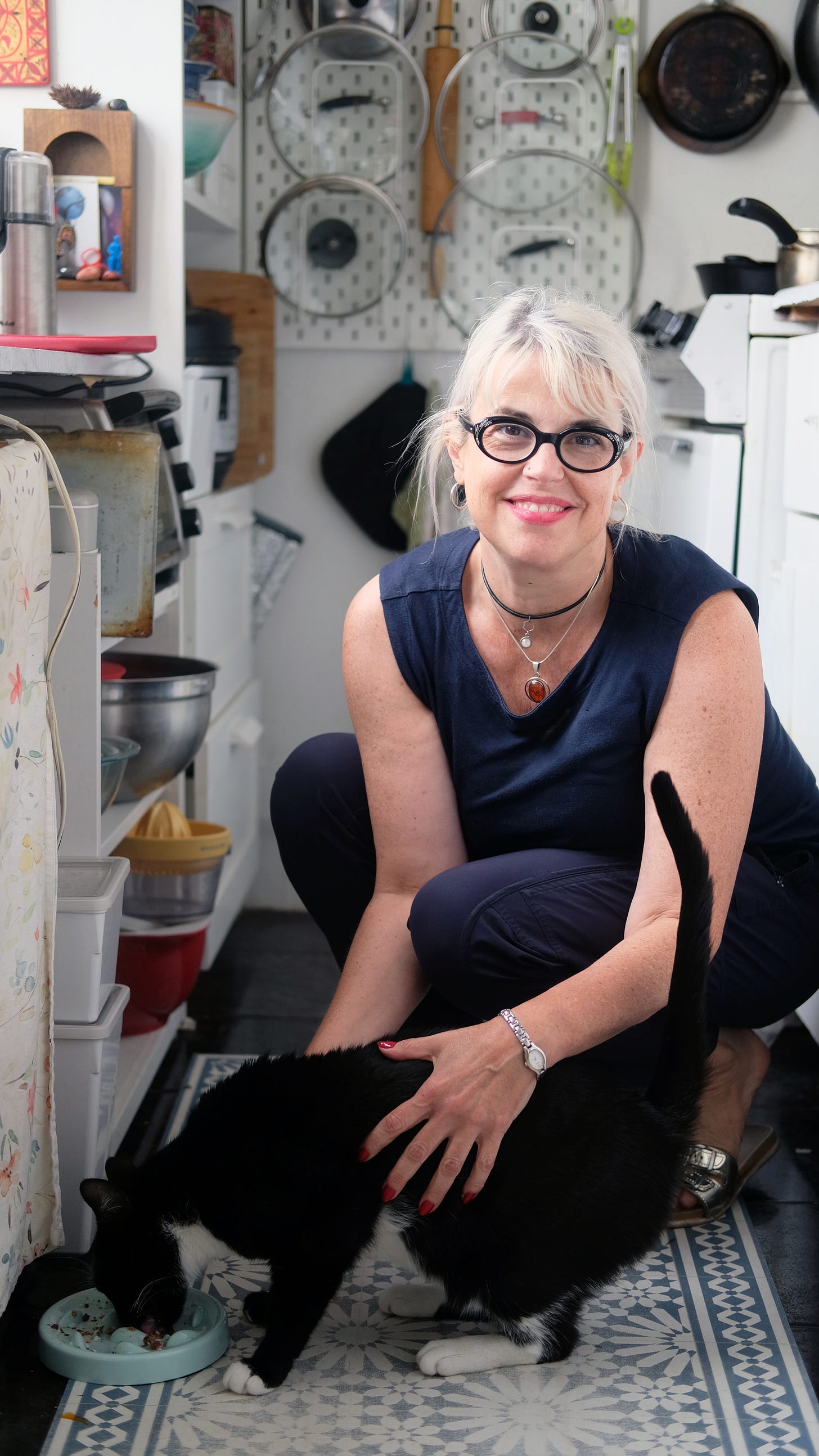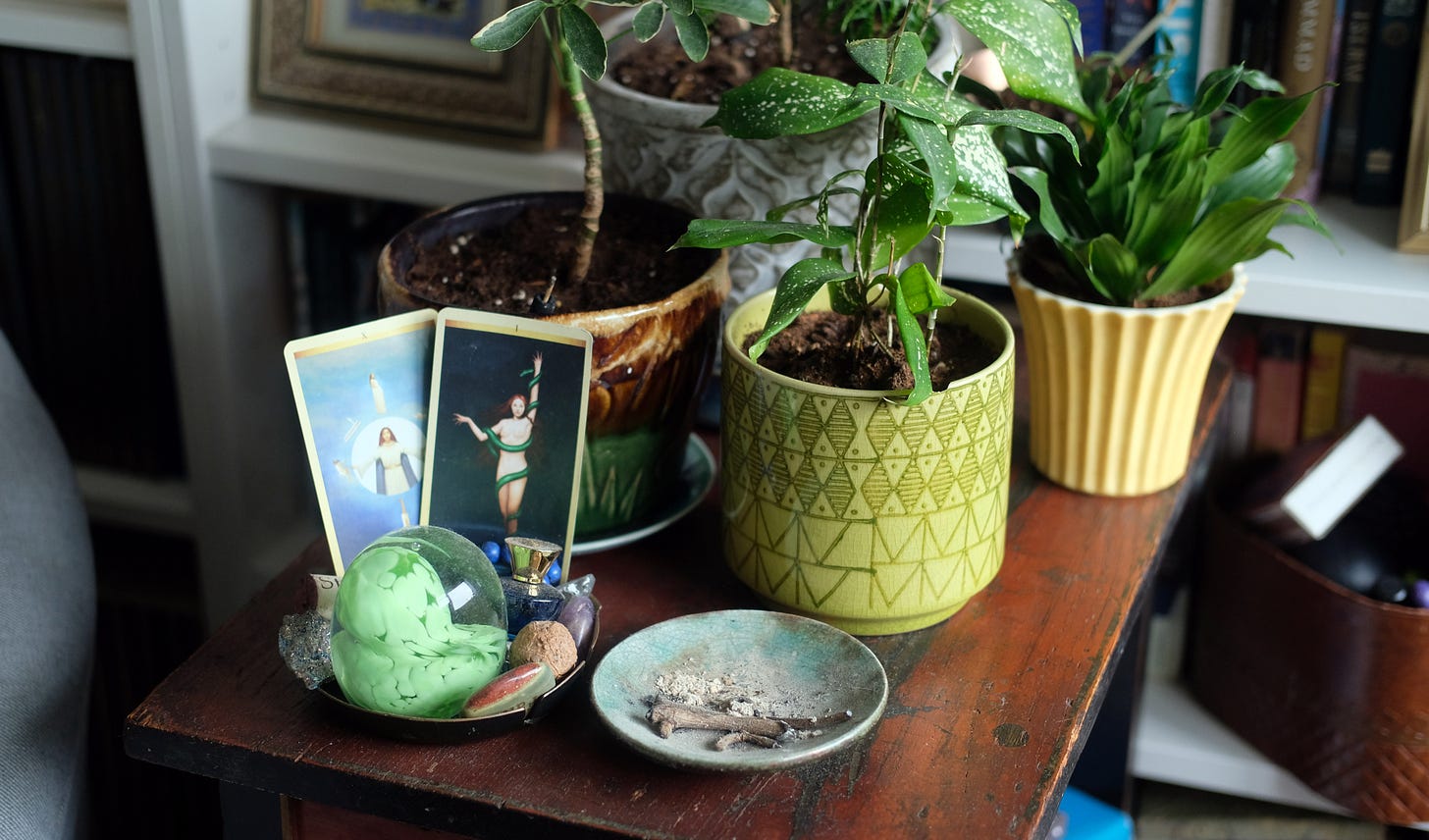Kristin Mathis TALKTALKTALKS the Art of Translation
Classics Scholar Kristin Mathis is on a mission to translate all 87 Orphic Hymns
Kristin Mathis is the only person I know who translates Sappho’s poetry for fun. It’s a hobby that sustained her during the years between dropping out of a Phd program at Princeton to work as an AIDS activist in New York City and launching her rogue academic career on Substack, where she shares her writing and commentaries on what has become her life’s mission: translating all 87 of the Orphic Hymns into living, breathing, English texts that preserve the esoteric content of the Ancient Greek.
While I’ve sat down in conversations with Kristin many times over the past year, the following interview was conducted over email. In it we discuss many things, including her relationship to magic and her complicated history with academia.
There are also many things we didn’t get to discuss. Like Kristin’s childhood spent in Malaysia. The time she met a Sun Bear. All those summers she spent in Paris. And much, much, more — because life is long if you’re really living and this interview is short.
Courtney ‘Vivi’ Henriette: Let’s start from the beginning. What languages do you speak? What languages do you read?
Kristin Mathis: Well, I speak Spanish nearly fluently — my son’s dad is Colombian — though I’m a little out of practice these days. My French is passable–better reading/listening than speaking unless I’m back in France, in which case it comes back to me after a few weeks. I took Italian in high school, but it’s pretty simple, and I speak with a Sicilian accent. (It was NJ in the 1980s.)
Reading: Greek is my best ancient language. My Latin has gotten really shoddy, but I can do it if I need to. For academic study, I read French, Italian, Spanish, Portuguese, and in a pinch, a little German.
CVh: Which came first, your interest in translation or magic? How do the two inform each other?
KM: I’d say my interest in magic came at just about the time I started to read Greek and Latin in college. I noticed that the Latin word “magia” was not really present in works before the Augustan period (roughly 1st c. CE), and I became curious about why that was. I eventually found myself writing my undergraduate thesis on notions of magic in Pliny the Elder’s Natural History. It won an award at Brown and helped get me on the radar of transdisciplinary Classics-Religious Study graduate programs that specialized in ancient Mediterranean religion — which in the early 1990s were primarily U Chicago and Princeton.
CVh: You’re one of the few people I know who has studied the occult academically. Tell me about your program.
KM: At Brown I was in the Religious Studies department. When I went to Princeton for my grad work, I was one of two students that year in a special interdepartmental initiative called the Program in the Ancient Mediterranean World (PAW) that straddled Classics, Religious Studies, History, and Art History.
Because I was in that program, I got to attend the ground-breaking 1994 seminar in magic held at the Institute for Advanced Studies at Princeton. (That’s a separate academic think-tank of sorts that is close to the university, but technically not affiliated with it.) That was where I met Hans Dieter Betz (who edited the Greek magical papyri), Dirk Obbink (Magika Hiera), and other scholars of ancient magic who are now very famous in their fields.
CVh: Tell me about that early path. What drew you there? What kept you there?
KM: I’ve always loved learning. As a little girl, I was drawn to anything about the pyramids or ancient history. At Brown, I used to spend hours and hours in my study carrel (for younger listeners: those were special desks assigned to you in the bowels of the library where you could keep books related to your research on shelves above your desk for easy access). I would get a rush every time I discovered something new…like the time back in 1993 when I realized that the astrologer Thrasyllus’ library was at the court of the emperor Tiberius, where Pliny would have had access.
That type of detective work was (and still is) my nerdy heart’s delight.
I also was fortunate as an undergrad to have professors who encouraged me and made a point of helping fund my work. I received two Ford Foundation grants in a row to be a research assistant for my professor Stanley Stowers, a scholar of early Christianity. His support was critical for a kid like me on a near-full scholarship, because it kept me fed and housed while teaching me the ins and outs of academic research.
“He was sitting there, as usual, engrossed in a Sanskrit book with a wide, radiant smile on his face and a halo of dusty sunshine around his head from a sunbeam. He looked like a medieval saint.”
CVh: What was it like studying with David Pingree? Any good stories to share? Mind sharing one?
KM: Pingree was already at retirement age when I was at Brown, but he was still working in his study and teaching the occasional class. I jumped on the chance to study medieval Indian history with him when he offered that during my freshman year. Mostly, I would just go talk to him about my research and pick his brain.
What a lovely man. He was the Platonic Ideal of an old college professor. He’d sit in his wood-paneled study in the Egyptology building with books and manuscripts — and even old scrolls — stacked everywhere around him, in about 5-6 different languages: Greek, Latin, Sanskrit, Egyptian hieroglyphs even. He would sit there with a beatific smile on his face.
I remember one time when I was beginning to research which astrology manuscripts Pliny the Elder would have had access to in Rome. I was hitting a wall. (Remember this was way before Chris Brennan’s work and at exactly the same time as Project Hindsight was just getting started.) I popped into Pingree’s office and poked my head through the door.
He was sitting there, as usual, engrossed in a Sanskrit book with a wide, radiant smile on his face and a halo of dusty sunshine around his head from a sunbeam. He looked like a medieval saint. He was so engrossed that he didn’t look up, so I just cleared my throat and said:
“Excuse me Professor Pingree, do you think that Thrasyllus would have brought a copy of Nechepso and Petosiris to the Tiberian court? And do you think that Balbillus would have inherited it? Or would it have become part of the official court library?”
Without missing a beat, he looked up from his Sanskrit and said:
“Oh yes, I think so. And I do think that even if Tiberius had taken the book for his own, Balbillus would have had access at the very least.”
He looked at me as if it was the most natural thing in the world that a 20-year-old girl with a mini Hello Kitty backpack (it was the 90s!) would be popping in with that exact question. I thanked him, and he said:
“Sounds like this thesis of yours is getting good. Do let me know if you find anything of interest!”
Then he went back to his reading.
“I don’t regret that move to leave academia one bit. Princeton felt like a mausoleum. Chelsea and the Village felt like the places where everything converged.”
CVh: Why did you ultimately decide to leave academics?
KM: It was a complicated mix of reasons.
1) I could feel myself getting to be a narrower and narrower person in academia. It was so heady, and although I excelled at being heady, I didn’t like who I was becoming. There’s no way (imho) to be in academia and not get pulled into the politics of departments, which is brutal. And at the time, there was extreme antipathy towards the actual spirituality of magic. You could attend a whole year-long seminar in magic and never once hear anyone talk about it from the perspective of the practitioner — like, maybe this stuff is really true. That was 100% verboten.
2) It was the early 90s. It felt frankly self-indulgent to be studying ancient texts while AIDS was all around us and so many gay folk were dying. I had always been a bit of a bohemian–artsy, club-going, interested in avant-garde film, etc. I wanted to do something that had actual impact on real, living people.
When I left academia after a lot of soul-searching, I went and worked at a little medical library in the Village where we distributed information on AIDS drugs and worked closely with groups like PWA (People with AIDS), ACT UP, and GMHC (Gay Men’s Health Crisis). I was a hotline worker at GMHC one night a week — going from The Limelight to the hotline to work and back.
I don’t regret that move to leave academia one bit. Princeton felt like a mausoleum. Chelsea and the Village felt like the places where everything converged.
CVh: You’ve mentioned in previous conversations that the idea to translate the Orphic Hymns just came to you. Mind elaborating?
KM: I had just finished translating the biggest surviving fragments of Sappho, and I was looking for something in Greek that was devotional. At around the same time, the pandemic hit. In one of the first months of lockdown, I had a dream that was nothing more than a booming voice saying, “I am the thought. The thought process. And then again, the thinker.”
The word for thought was the Greek nous. I thought to myself, well, I better investigate Hymns to Hermes, because this was definitely something speaking to me from another realm.
I googled Hymn to Hermes and one of the first things that came up was the Orphic Hymn. I started reading the Greek and was bowled over by how funny it was at the same time it was devotional. And so I dug in. At the time, I was still working as an school administrator, so I’d just translate one line every morning before work — just as a way to clear my head and get into the day.
CVh: A translation is a translation is a translation? Yeah? No? What is the art of translation?
KM: Ahhh…no. Translation is SUCH an art. And just like in art, there are pieces that resonate more or less, but there’s no such thing as WRONG art. (Except insofar as maybe it leads you down an unethical path.) For me, the art of translation is one of meditation and communion.
I take for-ev-er to translate a single hymn. I sit with the lines. I investigate the hell out of each and every word. And in doing so, a little world begins to open up.
This is true of any translation, but particularly of esoteric works like the Orphic Hymns. That’s because esoteric poetry not just has all the levels of meaning we’d find in any good poem (Sappho, for instance), but because in esoteric poetry, the poet has INTENTIONALLY created hidden layers of meaning to both hide spiritual meanings from the average reader, and simultaneously reveal meanings to the initiated — which is to say, those who have the keys to read it with sufficient depth and understanding.
CVh: How does your experience as a poet influence your work as a translator? Or does it not…?
KM: I think that because I’m a poet myself, I have an intuitive feeling for what the original poet may have been trying to do in a given line. I can see all the work a certain word is doing in that place. I get curious about why one word and not another. I’m intensely interested in the craft of poetry, and so I want to understand every level of the poem in detail. And I’d like to think that my translations are both faithful to the original and have beauty in their own right.
CVh: What is Mysteria Mundi?
KM: Mysteria Mundi is my project to translate all the Orphic Hymns, and to bring the beauty and wisdom of their underlying cosmology to our world today. The Hymns contain such medicine for the modern affliction of alienation–from ourselves, from each other, from the cosmos. And the Orphic cosmology also just happens to be the basis for Hellenistic astrology. That’s a big claim, I know, but I think I can support it.
CVh: Is there a planetary spirit you feel a certain affinity towards?
KM: Yes. I don’t really talk about it much, because it’s intensely personal, but my main relationship with a deity is actually with Sekhmet, an Egyptian goddess. That is not by my design, but by hers. Back in 1995 I had a life-changing experience with one of her statues in the Met Museum. She chose me in a very clear way, and I’ve never been the same since. (I’ve since found out that Kadmus separately had his own experience with those statues at a different time.)
In terms of Greek deities, it’s Venus. Always and always. C’mon, I’m a Libra rising, Taurus Moon. ‘Nuff said.
CVh: What guidance do you have for people looking to cultivate a more personal relationship with the planets?
KM: Make it simple. Don’t overthink. Despite my intensely nerdy nature, my own devotional practice is super, super simple. I have tiny mini-altars to each planet. I live in a studio apartment, so when I say mini-altars, I mean like a stone, maybe a seed or shell I picked up on a walk, and a little image of some sort. I might burn some incense on the planetary day if I remember.
I don’t do elaborate magic, and I’m not rigorous about my ritual. I never use the PGM, for example. That’s because it really all happens in my heart. My real worship is when I’m out on a walk and see the bush full of sparrows that reminds me of Venus. Or look out my window at the clouds floating by, and I think of Rhea and her role in guiding human souls into incarnations. Or when I go to chop my son’s veggies and think of Mars.
I try to live out my devotion to the planets in my relationships with people here on earth. I try to set good boundaries. I donate money to relief funds and volunteer in my neighborhood. I relish the moments I spend with my lover. That’s where the work is. It’s really not more complicated than that.
Subscribe to Kristin’s Substack, Mysteria Mundi, to read her writing and ongoing translations of the Orphic Hymns.
FOR FURTHER ENTERTAINMENT CHECK OUT:
TalkTalkTalk w/ Kristin Mathis of Mysteria Mundi — LISTEN HERE + WATCH HERE
Follow ART of the ZODIAC on INSTAGRAM and YOUTUBE+ SPOTIFY for the latest TalkTalkTalk
Wanna support TALKTALKTALK? Make new friends? Learn Astrology? Subscribe to ART of the ZODIAC on Patreon.









